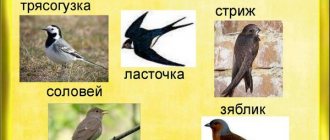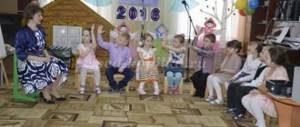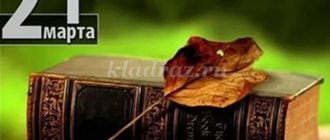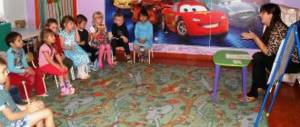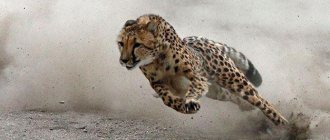“Bird Day” Ecological holiday for children of senior preschool age
Objectives: Educational: To consolidate children's knowledge about wintering and migratory birds, Seasonal changes in nature. Developmental : Develop attention and aesthetic perception of nature. Educational : To instill in children a humane attitude towards nature, a sense of responsibility for all life on Earth. Means of education and training: Disc with recordings of “Voices of Nature”. Pictures of wintering and migratory birds. The circles are green and blue according to the number of children. "Tangram" 2 pieces. Galoshes 2 pairs and “puddles” cut out of paper.
Preliminary work : learning poems about birds. Conversations on the topic of environmental education, reading works of fiction about birds and animals. Characters : Leader, two teams of preschool children.
1 team "Bee". 2nd team “Luchik”.
Progress of the holiday “Bird Day”
Presenter: They live on our planet
Wonderful creatures. They fly and sing, and keep the land holy. Tell me, children, is it possible to live without birds in the world? What will happen, what will happen If the birds disappear? Bugs, bugs, worms will attack the trees. And they will eat the bark, leaves, gnaw off the branches, buds - This is what will happen If the birds, if the birds All disappear, they will disappear. And there will be no chirping, The wondrous trills of the nightingale, And the magpies chirping, The chirp - chirp of the sparrow... It will be boring, the children know, to live without birds in this world.
Host: Tell me, what time of year is it now? The children answer. Host: That's right, spring. — What birds come to us in the spring from warm countries? The children answer. Host: That's right, birds. And now we will celebrate Bird Day and hold a fun spring competition with you. Conditions of the competition: 1. Give more correct answers to each question. 2. Do not give each other hints or interrupt. 3. For each correct answer, the team receives a point - a birdie. 4. At the end of the game we will count the points and see who won.
1 Task. “Answer the question” Team “Bee” begins - Which bird’s chicks don’t know their mother? (cuckoo) - Which bird has a long tongue? (woodpecker tongue 25 cm.) - What bird does not hatch eggs? (cuckoo) - Which bird is a symbol of peace? (pigeon) - Why shouldn’t you touch birds’ eggs and nests with your hands? —Which bird sees well in the dark? (owl) - What bird cannot see in the dark at all? (chicken) - Where does the cuckoo lay eggs? (to other people's nests) - The most famous crow? (Garkusha) - What bird doesn’t fly? (ostrich and penguin)
2 Task. “What a bird.”
Be careful, you have a new task. Now I will read you a short story about a bird, and you must name it, show a picture and say whether it is a wintering bird or a migratory bird, and why you think so. Team “Luchik” starts. Woodpecker. “I knock on tree trunks all day long. Of course, the sounds “knock-knock-knock” are not musical, but the trees enjoy them. I work from morning to evening: to do this, I need to rest firmly on the trunk with my elastic tail, cling to it with strong legs and peck with a strong beak. Then I insert a long tongue into the hollowed out hole, on which insects stick and prick, and send them into my mouth. Presenter: The team that correctly names and shows the bird will be considered the winner of this competition. Dynamic pause: Game “Who flies.” Rules of the game: Children stand in a circle. The driver names animate and inanimate objects that fly and do not fly. When naming objects, the leader raises his hands up, and the children raise both hands up and say the words “flies” only if the leader named a really flying object. 3 Task “Guess the riddle.” And now you listen carefully to the riddles and, having guessed it, raise the green circle - if the riddle is about spring. or a blue circle - if the riddle is about winter.
1. Who whitewashes the glades with white, And writes on the walls with chalk, Sews down feather beds, Decorates all the shop windows. (winter) 2. The streams rang. The rooks flew into the house of the bee. The bee brought the first honey. Who can say, who knows when this happens. (spring) 3. Draws without hands, bites without teeth. (frost) 4. Good, good He looks at people, But he doesn’t tell people to look at themselves. (sun) 5. White, but not sugar, No legs, but it goes. 6. She grows upside down Not in summer, but in winter, But the sun will bake her, She will cry and die. (icicle) 7. Without boards, without axes, the bridge across the river is ready. The bridge is like blue glass! Slippery, fun, light. (ice) 8. I run, as if on a ladder, over the pebbles, ringing From afar, by the song You will recognize me. (stream) 9. Stars are falling from the sky, They will lie on the fields, Let the Black earth hide under them. Many, many stars, thin as glass, the stars are cold, but the earth is warm. (snowflake) 10. There are dense lumps on the branches. Sticky leaves lie dormant in them. (kidneys) 11. We stood there all summer and waited for winter. When the time was right, we rushed down the mountain. (sleigh) 12. The rabble of all migratory birds, Cleans the arable land from worms. Jump back and forth across the arable land. And the bird's name is... Rook
4 Task: Captains Competition Listen carefully to the riddle and tell me what it is about. There is a palace on the pole, In the palace there is a singer. And his name is….. Starling.
Host: Tell me, what is the name of the starling’s house? Children's answers. Host: Now you must assemble the birdhouse.
5 Task: “Running in galoshes”
When spring comes and the snow melts, there are a lot of puddles on the street. In order not to get our feet wet, we need galoshes. Now you put on galoshes and run around the puddles so as not to get your feet wet, and then return to your team and hand them over. The team that runs around the puddles first and comes back wins.
6 Task: “Find out by description” Listen carefully and say what birds are hidden in these stories. 1. The top of the head is gray, as if wearing a gray cap. The chest and abdomen are also gray, and the back and wings are darker: they are brown and mottled. At the top, on the wings, there is a white stripe. There is a large black spot under the neck. (sparrow) 2. Her head is in a black cap, and there is a black tie on her neck and chest. the back, wings and tail are dark, and the breast is bright yellow. It’s as if she’s dressed up in a vest (tit) 3. She’s all black on top, only under the very tail there’s a white spot. The breast and belly are white. The tail is short, slightly forked, like a slingshot. (swallow) 4. How elegant he is! The head and back are black, there is a red spot on the back of the head, and white spots and stripes on the black wings. All motley. (woodpecker) Conclusion. Well, the time has come to sum up our holiday. Let's count the points, you can join me. DON'T FORGET THESE COMMANDMENTS!!! Never climb trees, they are alive! Never ruin a nest! Don’t forget to remove snow from the feeders and add food, but so as not to scare away the birds. DO NOT harm any animals! Don't deprive the earth of its beauty.
Development of extracurricular activities dedicated to BIRDS DAY
ADMINISTRATION OF CHELYABINSK MUNICIPAL EDUCATIONAL INSTITUTION SECONDARY SCHOOL No. 61 454047, Chelyabinsk, Teatralny lane, 16 a, tel/fax (351) 721-23-84
EXTRA-CLASS EVENT “WITHOUT PTI” “IT IS IMPOSSIBLE TO IMAGINE PLANET EARTH”
Gummetova Alena Yurievna Uranova Galina Vasilievna
Goals:
to introduce students to the diversity and vital activity of birds, to show the enormous importance of birds in nature and human life, to develop the ecological culture and creative potential of schoolchildren, to provide aesthetic education; increase interest in the nature of the native land; broaden the horizons of students.
Equipment:
multimedia support for the event
Progress of the event:
Birds, fish and animals look into people's souls. Feel sorry for them, people. Don't kill in vain! After all, the sky without birds is not heaven! And a sea without fish is not a sea! And a land without animals is not a land!
Teacher: Millions of years ago, the first birds appeared on Earth. And the hitherto gloomy world, inhabited only by dinosaurs, was filled with birdsong. And millions of years later, a person walked across the planet who was able to appreciate this singing. The man raised his head up, looked into the blue sky, and there was a lark in the sky! Sings, sings, flutters its wings. The man looked to the side, there was an eagle soaring, freely, easily.
Every year, ornithologists around the world traditionally celebrate April 1 as International Bird Day. This holiday began in 1906, when the International Convention for the Conservation of Birds was signed. In Russia, Bird Day appeared in 1926 on the initiative of young naturalists. Birds inhabit all corners of our planet. They are found high in the mountains, and in the icy subpolar void, and in hopeless sands, and over the vast expanses of the oceans. They delight us with their swift, easy flight, beautiful singing, varied colors of plumage. We are accustomed to the proximity of birds, accustomed to seeing and hearing them . Perhaps that is why many beliefs, sayings, fairy tales, songs, legends, one way or another, are associated with birds.
How well do we know the birds that live in our neighborhood? What are their habits? I think that not only most children, but also adults will find it difficult to answer these and many other questions. The fact is that seeing birds in nature, much less observing them, is a difficult task, requiring special training, skills, patience, dedication and unlimited time.
Guys, why do you think we can’t do without birds? (Birds are our childhood friends; messengers of joy, bringing spring; our faithful helpers, protectors of forests and fields, gardens and vegetable gardens; birds are beauty and mystery.) What benefits do birds bring to people? (In one day, a starling can eat as many caterpillars as it weighs itself and will not get fat at all, since it spends a lot of energy searching for food, building a nest, and caring for chicks.)
Do you know that the cuckoo eats up to 270 thousand large caterpillars and cockchafers over the summer. The rook, following the plow, is capable of destroying 400 worms - plant pests - in a day. The family of swallows destroys about a million different harmful insects over the summer. The long-eared owl can eat up to 10 voles a day, and the barn owl eats about 1,200 rodents a year. The steppe eagle destroys a lot of ground squirrels and mice. It is estimated that one mouse eats 2–3 kg of grain per year, and a gopher eats up to 16 kg. This means that every owl and eagle saves tons of bread from rodents. Well, guys, now you know what great benefits birds bring, and our holiday today is dedicated to these inhabitants of planet Earth.
Teacher: Today we have gathered here to identify the best bird expert among the students in our class. Dear guys, game participants and dear spectators! We are starting KVN and dedicating it to birds. Two teams play: “Swallows” and “Ivolga”.
Our KVN will be judged by a jury of three people. (The presenter introduces the jury members.) To determine which team will be the first to start our KVN, a draw will be held. (Team captains are invited to puncture a balloon, one of two, and find out which number is inside the balloon.)
FIRST COMPETITION – “WELCOMING TEAMS”. (Team greetings are prepared in advance). The word for greetings is given to the "SWALLOWS" team
Hello everyone, gentlemen! We flew here, you, of course, are right there, they call us “Swallows”. We are a winged team, We are a team no matter where we are, At school we play as our own, Now we have come here. We will respect our opponents, we will play together. Our goal is very simple - to show our knowledge. And in the end, we will know everything about birds better.
The word for greetings is given to the IVOLGA team
The nut of knowledge is hard, But we don’t like to retreat! The inquisitive club plays and challenges Team “Swallows” to Team “Ivolga” for a duel. Oriole is an intelligent, cheerful, very inquisitive team, ready to play. Our motto: “Don’t be discouraged, keep your head up!”
(The jury sums up the results and announces the result.) SECOND COMPETITION – “BLITZ TOURNAMENT”. Each team must answer ten questions at lightning speed. For this competition you will receive as many points as you give correct answers. Questions for the blitz tournament: 1. Which bird has the longest tongue? (The woodpecker has 15 cm.) 2. What bird does not land on the ground, on the water, or on a tree? (Swift.) 3. When is the sparrow’s body temperature lower - in winter or summer? (Same.) 4. A bird that exterminates rodents? (Owl.) 5. A bird with completely black plumage? (Raven.) 6. Birds that breed in winter? (Brosbill.) 7. What birds are called albinos? (Birds that do not have pigment.) 8. Which bird has a nest that looks like a mitten? (The titmouse.) 9. Who has the most amazing nose? (For the crossbill - with a cross, for flamingos - with a boomerang.) 10. What are the fastest birds? (Falcons - 300 km/h; swifts 170 km/h) 11. What birds do not hatch eggs? (Cuckoos.) 12. Crawling birds? (Nuthatch.) 12. Name five songbirds? (For example, a nightingale, a lark, a chaffinch, a tit, a blackbird.) 13. How does a magpie’s nest differ from a crow’s nest? (The magpie is flat, the crow is round with a lid.) 14. Who is the forest rooster? (Caercaillie) 15. What bird can walk under water, but it winters in the voids under the ice, where it gets through an ice hole? (Dipper) 16. Name a bird that can fly with its tail forward, backwards and sideways. (Hummingbird) 17. What birds can chase a car? (Ostriches) 18. Which bird is called the forest doctor? (Woodpecker) 19. Why does a woodpecker’s head not hurt from knocking, and the brain is not damaged? 20. The smallest bird in our country. (King) 21. Which bird flies the highest? (Eagle) 22. The eagle is a strong bird, with a sharp beak and sharp claws, a symbol of power and authority. Which states placed the eagle on their coats of arms? (Russia, Poland, USA). 23. What birds can be seen in the starry sky? 24. What birds hatch their chicks in the rain? (Swans) 25. Name a bird that can sleep while flying? (Stork) 26. Name fairy tales in which birds are the main characters. (The Ugly Duckling, Wild Swans, Gray Neck, Crane and Heron, Cuckoo, Fox and Black Grouse, etc.) Well done! The jury sums up the results, announces the result,
And we continue: the next COMPETITION: “BAROMETERS OF NATURE”
Based on the behavior of birds in nature, you need to guess what kind of weather they predict; the team that names the most correct answers wins. 1. Swallows touch the surface of the water with their wings. (For rain.) 2. Swallows fly up and down. (Wait for the storm.) 3. Swifts fly low screaming. (For rain.) 4. Sparrows hide under the eaves. (To the storm.) 5. The bullfinch whistles. (It will be winter soon.) 6. The bullfinch is chirping under the windows. (Towards the thaw.) 7. The oriole makes sharp sounds, similar to a cat’s squeal. (To bad weather.) 8. Pigeons coo, cuckoos cuckoo. (For warm weather.) 9. Sparrows bathe in the sand. (It will rain.) 10. The crows sit on the tops of the trees. (Before the frost.) 11. Crows sit on the snow. (Towards the thaw.) 12. Swallows bathe and often fly to the nest. (For rain.) 13. A seagull walks on the sand, promises melancholy to the sailor, a seagull sat down on the water, wait... (for good weather.) 14. During the day, an owl cries. (For the rain.) (The jury sums up the results of the blitz tournament and announces the result.)
NEXT COMPETITION: “CAPTAINS COMPETITION” The highest score is three points. To warm up, we invite the captains to ask each other one question about birds. (The captains ask each other questions and answer them.) And now, dear captains, we invite you to take part in the “Who is Greater” auction. We all played and play in cities. Our auction is very similar to this game, only instead of cities you name birds. For example, hawk, golden eagle, black grouse, etc. The one who cannot name the next bird loses. (The jury evaluates the captains’ competition and announces the results.) The “Captains’ competition” has ended, both captains showed their dexterity and intelligence. Well done! COMPETITION "FOUR ONE". Each team will now receive two cards with the names of four birds. Three of these birds are united by some common feature, and one is extra. Which one is up to you to determine. Don't forget to cross it off the list. Examples of cards: 1. Three of the birds listed here are wintering, and one is migratory. Find her. (Tit, bullfinch, woodpecker, rook.) 2. Among the birds indicated here, one is not a songbird. Which? (Nightingale, redstart, warbler, snipe.) 3. Three birds live in mixed forests, one in the steppes. Please indicate it. (Caercaillie, chaffinch, demoiselle, waxwing.) 4. One of these birds is not a bird of prey. Which? (Hawk, vulture, falcon, swift.) While the teams are completing the task, a “GAME WITH FANS” is held. 1. Sun birds, singers of the dawn. Who are we talking about? (About roosters.) 2. Name the largest group of our birds. (Passerines - 63% of all birds, more than 5 thousand.) 3. The blackest of all migratory birds, Cleans the arable land of worms, Jumps back and forth across the arable land, And the bird’s name is... rook.
4. Together we built a house for the feathered guests, Or rather, a palace, Come quickly... starling.
5. Stands on one leg, looks intently into the water, pokes his beak at random - looks for baby frogs in the river. A drop hung on my nose... you know? This is... a heron.
6. How fast can an ostrich run? (Up to 50 km/h.)
7. What is the body temperature of most birds? (About 41 degrees.)
8. Which bird has the largest wingspan? (Albatross, over 5.5 meters.)
9. On what day of the year in Rus' was it customary to release birds into the wild? (April 7 - Annunciation.)
10. How many breeds of pigeons have been bred by humans? (Over 800.)
Well done!
COMPETITION “KNOW ME” you need to determine who we are talking about based on the description of the birds and their habits: 1. This bird can be seen in the winter in the park, in the garden, at the feeders in a flock of tits. This small, short-tailed bird immediately attracts attention with its ability to quickly run upside down along a tree trunk. (NUTHATH) 2. Small songbirds, flying home from distant travels, put on a bright, festive outfit. This bird arrives in mid-April and is smaller than a sparrow. Itself is bluish-gray, with a black periorbital stripe. The forehead is white, the throat is black, and the tail and underside of the body are red-orange. (REDSTART) 3. A very beautiful bird that can be seen in flocks. A red mask near the beak, the back and spots on the chest are black, there is a wide yellow stripe on the wings, the chest and belly are white. It feeds on the seeds of various plants. (GOLDINCH) 4. There are many varieties of tits. There are big tits, and there are little ones. Previously, November 12 was celebrated as Tit Day. Tufted tit. They recognize her by the upturned crest on her head. She not only destroys aphids and small spiders, but also gets the seeds of cones; she is a specialist in coniferous trees. What is it also called? (GRENADIER) 5. In the distant past, these birds lived in the mountains. That's why they like to nest in attics and rooftops. (DOVE) Well, we are convinced that you know almost everything about birds.
FINAL COMPETITION “BIRDS ADVERTISING” (It is worth two points)
The teams prepared this task in advance, and no one knew what each of them came up with. Let's see what they came up with! (Each team shows or tells, in the form of a poem or song, that is, as original as possible, the role of a protected bird in nature and human life.)
“GAME WITH FANS” While our teams are preparing, let’s find out from the fans how they know proverbs about birds. I start, and you finish: That bird is bad (whose nest is not nice). The word is not a sparrow, (if it flies out, you won’t catch it). Better is a bird in the hand (than a pie in the sky). Goose is a pig (not a friend). An old sparrow (you can’t fool him on chaff). On someone else’s side, (glad about his little crow). The raven won’t peck out the crow’s eye. Every sandpiper (praises his swamp).
(The jury evaluates the teams' performances.) SUMMARY. AWARDS FOR GAME PARTICIPANTS
Used literature: 1. Anashkina E.N.
300 questions and answers about birds. – Yaroslavl: “Academy of Development”, 1998. – 240 p. 2. Bram A.E. Animal life: In 3 vols. T. 2: Birds. – M.: TERRA, 1992. – 352 p.: ill. 3. Dementyev G.P., Ornithology, in the collection: Development of biology in the USSR, - M., 1967 4. Ilyichev V.D., N.N. Kartashov, I.A. Shilov. General ornithology. - Moscow, Higher School, 1982. 5. Ilyichev V. D. (ed.). Fauna of the world. Birds. - M., Agropromizdat. 1991. 6. Kartashev N. N. Systematics of birds. - M., Higher School. 1974. 7. Mikheev A.V. Biology of birds. — M.: “Citadel”. 1996. 8. Paevsky V. A. Bird catchers from science. - St. Petersburg. 2001. 9. Birds of the USSR. Bibliographic index, 1881-1917, c. 1, L., 1972 10. Cheltsov-Bebutov A. M. Ecology of birds. - M.: Publishing House of VoGU. 1982. 11. April 1 - International Bird Day | Red Book of the Chelyabinsk Region [Electronic resource]: www.redbook.ru/article217.html saved copy (access date: 07/10/2009). For the full text of the material Development of an extracurricular event dedicated to BIRDS DAY, see the downloadable file
. The page contains a fragment.
| Author: Gummetova Alena Yuryevna, Uranova G.V → kotik6678 03/20/2010 0 23236 2147 | Comment |
Thank you for your mark. If you want your name to be known to the author, log in to the site as a user and click Thank you again. Your name will appear on this page.
Login | Registration
Have an opinion? Leave a comment
